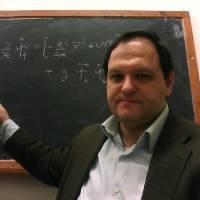Next up
Time-dependent Schrodinger equation
Continuing in
Quantum Physics of Light and Matter - Quantum Field Theory of Non-Relativistic Matter
This is a preview of subscription content
Your browser needs to be JavaScript capable to view this video
Try reloading this page, or reviewing your browser settings
You're watching a preview of subscription content. Log in to check access
This video deals with the second quantization of the Schroedinger field, namely the quantum field theory of the non-relativistic massive matter made of fermions or bosons. The video is divided into 6 segment.
The first segment reviews the main properties of the time-dependent Schroedinger equation. The second segment discusses the second quantization of the energy of the Schrodinger field; the third clip analyzes the ladder operators in the case of bosonic matter and in the case of fermionic matter, and the fourth segment develops the quantum field theory of non-relativistic matter at finite temperature. The fifth one compares first quantization with second quantization for a generic interacting many-body system of identical massive and non-relativistic particles, and the sixth segment develops the theory of coherent states for bosonic and fermionic particles.
The ideal viewer is a MSc or PhD student of Physics or Chemistry or Engineering, who will learn about the time-dependent Schodinger equation, the second quantization of the Schrodinger energy, the ladder operators for bosons and fermions, finite-temperature effects, and the differences between Fock and coherent states for bosons and fermions.
Introduction
Deals with the 2nd quantization of the Schroedinger field, the time-dependent Schoedinger equation, and the ladder operators for bosons and fermions.
About The Author

Luca Salasnich is an Associate Professor of Theoretical Physics of Matter at University of Padova, Italy. He was previously a research scientist with the Italian National Research Council (CNR). Dr. Salasnich was awarded an MSc in Physics by the University of Padova in 1991, and his PhD in Theoretical Physics by the University of Florence in 1995. His fields of research are condensed matter theory and statistical physics, in particular nonlinear phenomena and macroscopic quantum effects (like superfluidity and superconductivity) in ultra-cold atomic gases and other many-body systems. At the University of Padova, Dr. Salasnich is a member of the Scientific Committee of Area 2 (Physical Sciences) and President of the Teaching Council for the BSc in Optics and Optometrics. He has written more than 130 scientific papers for international journals, with over 2500 citations.
About this video
- Author(s)
- Luca Salasnich
- DOI
- https://doi.org/10.1007/978-3-030-63300-4
- Online ISBN
- 978-3-030-63300-4
- Total duration
- 1 hr 9 min
- Publisher
- Springer, Cham
- Copyright information
- © The Editor(s) (if applicable) and The Author(s), under exclusive license to Springer Nature Switzerland AG 2020
Related content
Video
- Luca Salasnich
Video
- Luca Salasnich
Video
- Luca Salasnich
Video
- Luca Salasnich
Video Transcript
[MUSIC PLAYING]
In this video, we shall consider and analyze the quantum field theory of non-relativistic matter. This is the summary of what I will discuss.
First, though, the review of the time-dependent Schrodinger equation, focusing on the energy constant of the time-dependent Schrodinger field. The fact is that this Schrodinger field can be written as an expansion of modes of single excitations. And the quantization of these modes give rise to the quantum Hamiltonian we’re talking about– the Schrodinger field.
This quantization is based on the chosen commutational rules, which can be bosonic or fermionic. And in this way, with the same field we can describe both identical bosons and identical fermions, changing the commutational rules.
This second quantization is very useful also at finite temperature. And I will show some applications. I will also discuss the connection between the first quantization and the second quantization, taking also into account the interaction between particles.
Finally, I will discuss the coherent states for bosons and fermions. These coherent states are the states which are more close to the classical physics, and indeed apply in coherent states. Because we will see we will move from quantum field theory to classical theory, both for bosons and fermions.